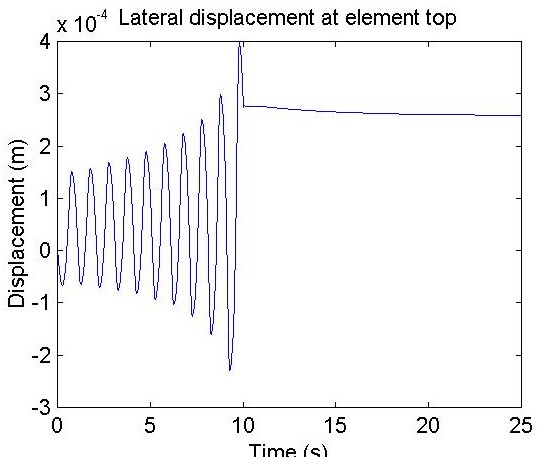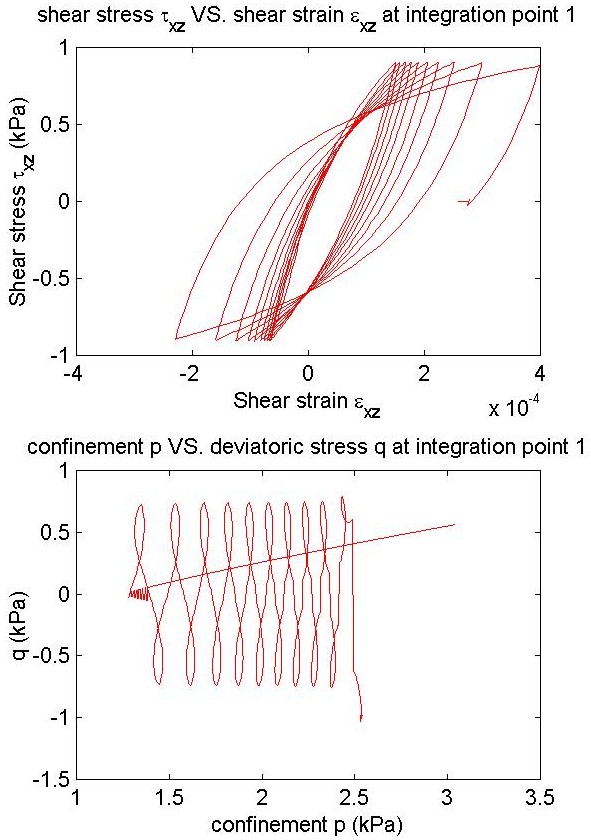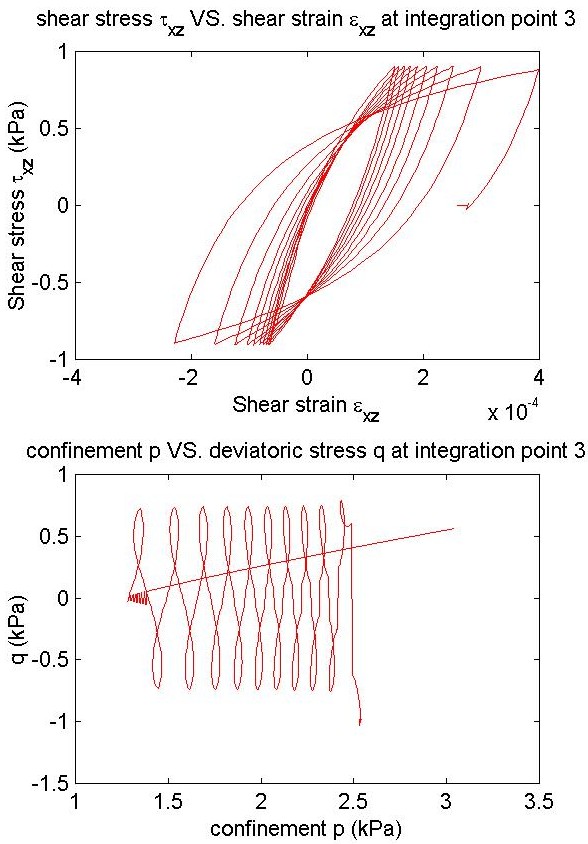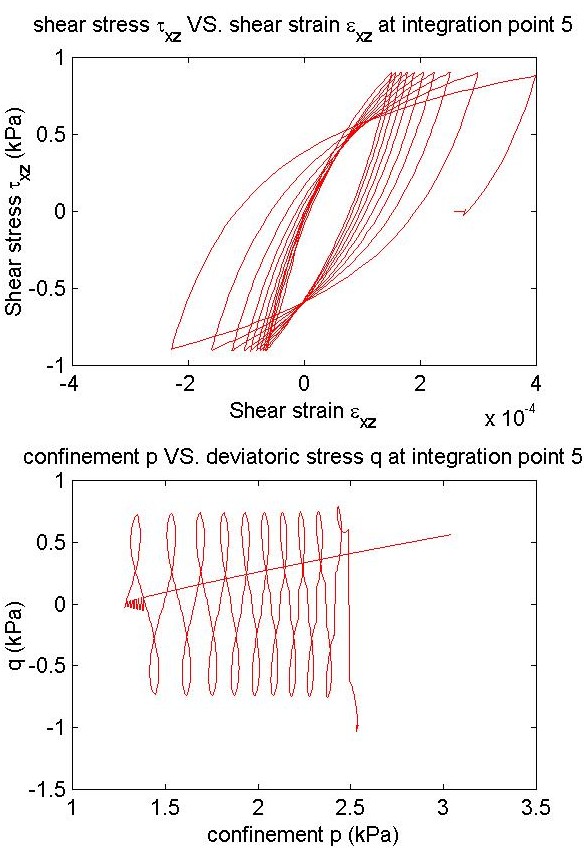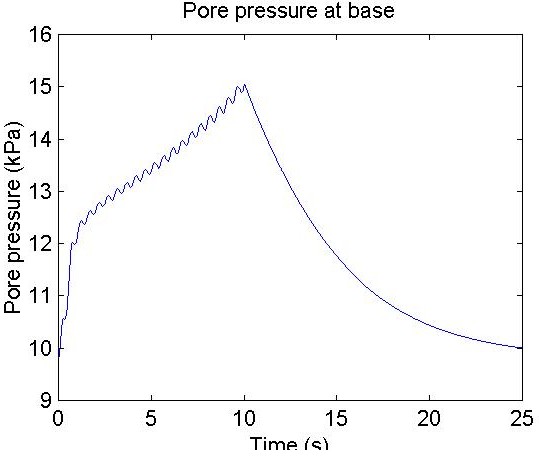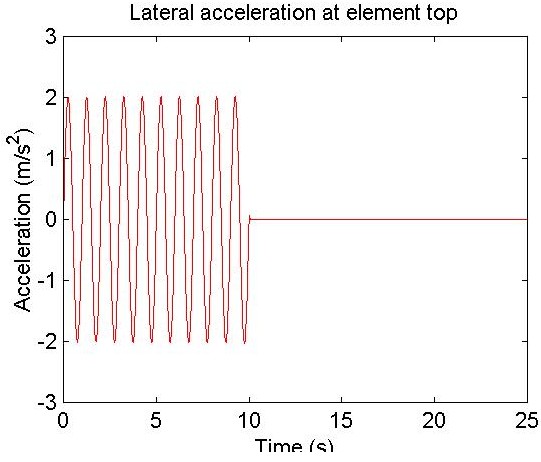PressureDependMultiYield02-Example 2
Jump to navigation
Jump to search
- Command_Manual
- Tcl Commands
- Modeling_Commands
- model
- uniaxialMaterial
- ndMaterial
- frictionModel
- section
- geometricTransf
- element
- node
- sp commands
- mp commands
- timeSeries
- pattern
- mass
- block commands
- region
- rayleigh
- Analysis Commands
- Output Commands
- Misc Commands
- DataBase Commands
Input File
# single BrickUP element with pressure dependent material.
# subjected to 1D sinusoidal base shaking
# Written by Jinchi Lu and Zhaohui Yang (May 2004)
wipe
set friction 31. ;#friction angle
set phaseTransform 26. ;#phase transformation angle
set G1 9.e4 ;
set B1 22.e4 ;
set gamma 0.600 ;# Newmark integration parameter
set dt 0.01 ;# time step for analysis, does not have to be the same as accDt.
set numSteps 2500 ;# number of time steps
set rhoS 1.80 ;# saturated mass density
set rhoF 1.00 ;# fluid mass density
set Bfluid 2.2e6 ;# fluid shear modulus
set perm 1.e-5 ;#permeability (m/s)
set accGravity 9.81 ;#acceleration of gravity
set perm [expr $perm/$accGravity/$rhoF] ;# actual value used in computation
set matTag 1 ;# material tag
set accMul 1 ;# acceleration multiplier
set pi 3.1415926535 ;
set inclination 0;
set massProportionalDamping 0.0 ;
set InitStiffnessProportionalDamping 0.002;
set gravityX [expr $accGravity*sin($inclination/180.0*$pi)] ;# gravity acceleration in X direction
set gravityY 0.0 ;# gravity acceleration in Y direction
set gravityZ [expr -$accGravity*cos($inclination/180.0*$pi)] ;# gravity acceleration in Z direction
set ndm 3 ;# space dimension
model BasicBuilder -ndm $ndm -ndf 4
nDMaterial PressureDependMultiYield02 $matTag $ndm $rhoS $G1 $B1 $friction 0.1 80 0.5 \
$phaseTransform 0.067 0.23 0.06 0.27
node 1 0.00000 0.0000 0.00000
node 2 0.00000 0.0000 1.00000
node 3 0.00000 1.0000 0.00000
node 4 0.00000 1.0000 1.00000
node 5 1.00000 0.0000 0.00000
node 6 1.00000 0.0000 1.00000
node 7 1.00000 1.0000 0.00000
node 8 1.00000 1.0000 1.00000
element brickUP 1 1 5 7 3 2 6 8 4 $matTag $Bfluid $rhoF $perm $perm $perm $gravityX $gravityY $gravityZ
updateMaterialStage -material $matTag -stage 0
fix 1 1 1 1 0
fix 2 0 1 0 1
fix 3 1 1 1 0
fix 4 0 1 0 1
fix 5 1 1 1 0
fix 6 0 1 0 1
fix 7 1 1 1 0
fix 8 0 1 0 1
# equalDOF
# tied nodes around
equalDOF 2 4 1 3
equalDOF 2 6 1 3
equalDOF 2 8 1 3
set nodeList {}
for {set i 1} {$i <= 8 } {incr i 1} {
lappend nodeList $i
}
set elementList {}
for {set i 1} {$i <= 1 } {incr i 1} {
lappend elementList $i
}
# GRAVITY APPLICATION (elastic behavior)
# create the SOE, ConstraintHandler, Integrator, Algorithm and Numberer
numberer Plain
system ProfileSPD
test NormDispIncr 1.0e-8 20 1
algorithm KrylovNewton
constraints Penalty 1.e18 1.e18
set nw 1.5
integrator Newmark $nw [expr pow($nw+0.5, 2)/4]
analysis Transient
analyze 10 5.e0
# switch the material to plastic
updateMaterialStage -material $matTag -stage 1
analyze 10 5.e1
setTime 0.0 ;# reset time, otherwise reference time is not zero for time history analysis
wipeAnalysis
############# create recorders ##############################
eval "recorder Node -file disp -time -node $nodeList -dof 1 2 3 -dT 0.01 disp"
eval "recorder Node -file acc -time -node $nodeList -dof 1 2 3 -dT 0.01 accel"
eval "recorder Node -file pwp -time -node $nodeList -dof 4 -dT 0.01 vel"
eval "recorder Element -ele $elementList -time -file stress1 -dT 0.01 material 1 stress"
eval "recorder Element -ele $elementList -time -file strain1 -dT 0.01 material 1 strain"
eval "recorder Element -ele $elementList -time -file stress3 -dT 0.01 material 3 stress"
eval "recorder Element -ele $elementList -time -file strain3 -dT 0.01 material 3 strain"
eval "recorder Element -ele $elementList -time -file stress5 -dT 0.01 material 5 stress"
eval "recorder Element -ele $elementList -time -file strain5 -dT 0.01 material 5 strain"
############# create dynamic time history analysis ##################
pattern UniformExcitation 1 1 -accel "Sine 0 10 1 -factor $accMul"
integrator Newmark $gamma [expr pow($gamma+0.5, 2)/4]
rayleigh $massProportionalDamping 0.0 $InitStiffnessProportionalDamping 0.0
constraints Penalty 1.e18 1.e18 ;# can't combine with test NormUnbalance
test NormDispIncr 1.0e-3 25 0 ;# can't combine with constraints Lagrange
#algorithm Newton ;# tengent is updated at each iteration
algorithm KrylovNewton ;#
system ProfileSPD ;# Use sparse solver. Next numberer is better to be Plain.
numberer Plain ;# method to map between between equation numbers of DOFs
analysis VariableTransient ;# splitting time step requires VariableTransient
############# perform the Analysis and record time used #############
set startT [clock seconds]
analyze $numSteps $dt [expr $dt/64] $dt 15
set endT [clock seconds]
puts "Execution time: [expr $endT-$startT] seconds."
MATLAB Plotting File
clear all;
a1=load('acc');
d1=load('disp');
p1=load('pwp');
s1=load('stress1');
e1=load('strain1');
s5=load('stress3');
e5=load('strain3');
s9=load('stress5');
e9=load('strain5');
fs=[0.5, 0.2, 4, 6];
fs2=[0.5, 0.2, 4, 3];
accMul = 2;
%integration point 1 p-q
po=(s1(:,2)+s1(:,3)+s1(:,4))/3;
for i=1:size(s1,1)
qo(i)=(s1(i,2)-s1(i,3))^2 + (s1(i,3)-s1(i,4))^2 +(s1(i,2)-s1(i,4))^2 + 6.0* (s1(i,5)^2 +s1(i,6)^2+s1(i,7)^2) ;
qo(i)=sign(s1(i,7))*1/3.0*qo(i)^0.5;
end
figure(1); close 1; figure(1);
%integration point 1 stress-strain
subplot(2,1,1), plot(e1(:,7),s1(:,7),'r');
title ('shear stress \tau_x_z VS. shear strain \epsilon_x_z at integration point 1');
xLabel('Shear strain \epsilon_x_z');
yLabel('Shear stress \tau_x_z (kPa)');
subplot(2,1,2), plot(-po,qo,'r');
title ('confinement p VS. deviatoric stress q at integration point 1');
xLabel('confinement p (kPa)');
yLabel('q (kPa)');
set(gcf,'paperposition',fs);
saveas(gcf,'SS_PQ_p1','jpg');
%integration point 5 p-q
po=(s5(:,2)+s5(:,3)+s5(:,4))/3;
for i=1:size(s5,1)
qo(i)=(s5(i,2)-s5(i,3))^2 + (s5(i,3)-s5(i,4))^2 +(s5(i,2)-s5(i,4))^2 + 6.0*( s5(i,5)^2 + s5(i,6)^2 + s5(i,7)^2);
qo(i)=sign(s5(i,7))*1/3.0*qo(i)^0.5;
end
figure(5); close 5; figure(5);
%integration point 5 stress-strain
subplot(2,1,1), plot(e5(:,7),s5(:,7),'r');
title ('shear stress \tau_x_z VS. shear strain \epsilon_x_z at integration point 3');
xLabel('Shear strain \epsilon_x_z');
yLabel('Shear stress \tau_x_z (kPa)');
subplot(2,1,2), plot(-po,qo,'r');
title ('confinement p VS. deviatoric stress q at integration point 3');
xLabel('confinement p (kPa)');
yLabel('q (kPa)');
set(gcf,'paperposition',fs);
saveas(gcf,'SS_PQ_p3','jpg');
%integration point 9 p-q
po=(s9(:,2)+s9(:,3)+s9(:,4))/3;
for i=1:size(s1,1)
qo(i)=(s9(i,2)-s9(i,3))^2 + (s9(i,3)-s9(i,4))^2 +(s9(i,2)-s9(i,4))^2 + 6.0*( s9(i,5)^2 + s9(i,6)^2 + s9(i,7)^2);
qo(i)=sign(s9(i,7))*1/3.0*qo(i)^0.5;
end
figure(6); close 6; figure(6);
%integration point 9 stress-strain
subplot(2,1,1), plot(e9(:,7),s9(:,7),'r');
title ('shear stress \tau_x_z VS. shear strain \epsilon_x_z at integration point 5');
xLabel('Shear strain \epsilon_x_z');
yLabel('Shear stress \tau_x_z (kPa)');
subplot(2,1,2), plot(-po,qo,'r');
title ('confinement p VS. deviatoric stress q at integration point 5');
xLabel('confinement p (kPa)');
yLabel('q (kPa)');
set(gcf,'paperposition',fs);
saveas(gcf,'SS_PQ_p5','jpg');
figure(2); close 2; figure(2);
%node 3 displacement relative to node 1
plot(d1(:,1),d1(:,5));
title ('Lateral displacement at element top');
xLabel('Time (s)');
yLabel('Displacement (m)');
set(gcf,'paperposition',fs2);
saveas(gcf,'Disp','jpg');
s=accMul*sin(0:pi/50:20*pi);
s=[s';zeros(3000,1)];
s1=interp1(0:0.01:40,s,a1(:,1));
figure(3); close 3; figure(3);
%node acceleration
a = plot(a1(:,1),s1+a1(:,5),'r');
title ('Lateral acceleration at element top');
xLabel('Time (s)');
yLabel('Acceleration (m/s^2)');
set(gcf,'paperposition',fs2);
saveas(gcf,'Acc','jpg');
figure(4); close 4; figure(4);
a=plot(p1(:,1),p1(:,2));
title ('Pore pressure at base');
xLabel('Time (s)');
yLabel('Pore pressure (kPa)');
set(gcf,'paperposition',fs2);
saveas(gcf,'EPWP','jpg');
Displacement Output File
Stress-Strain Output File (integration point 1)
Stress-Strain Output File (integration point 3)
Stress-Strain Output File (integration point 5)
Excess Pore Pressure Output File
Acceleration Output File
Return to:
- NDMaterial Command
- UC San Diego soil models (Linear/Nonlinear, dry/drained/undrained soil response under general 2D/3D static/cyclic loading conditions (please visit UCSD for examples)
- UC San Diego Saturated Undrained soil
- Element Command
- UC San Diego u-p element (saturated soil)
- Related References
